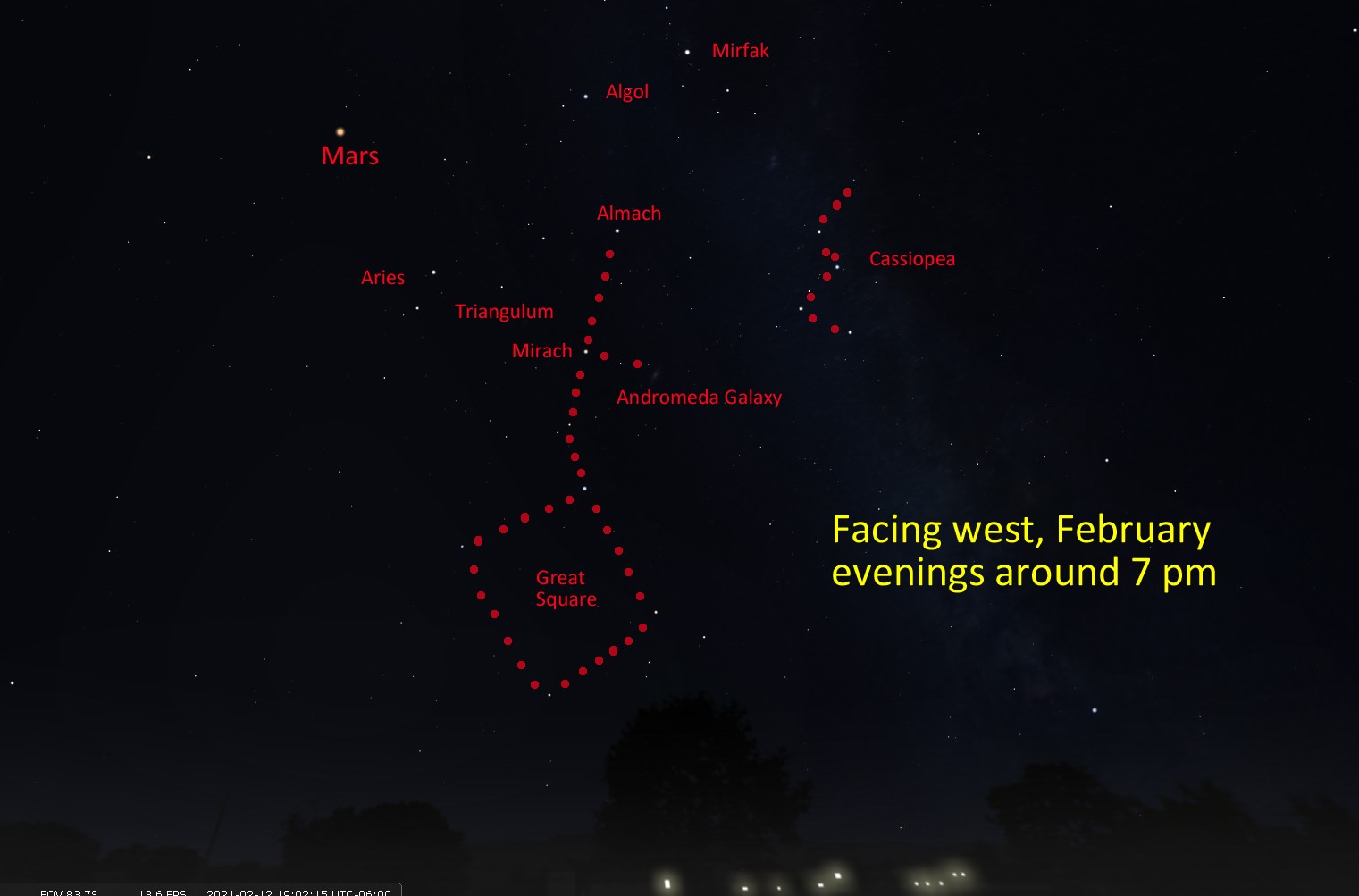This month, I will focus on two slightly challenging but fun sky sights. The Andromeda Galaxy, famous in science fiction, is a galaxy of about 1 trillion stars and is believed to be somewhat similar to our own Milky Way Galaxy. It is the nearest large galaxy to ours, but the distance to objects in the universe is enormous. The standard measuring stick is the light-year. Since the speed of light has been measured at 186,300 miles per second, light from the Moon takes just over one second and from the Sun about eight minutes to get to your eyes. By this measure, the nearest star outside of our solar system is over four light years, or 25 trillion miles away! All of this pales in comparison to the staggering 2.5 million years that it takes light from the Andromeda Galaxy to get to your eyes. In fact, it is often termed to be the most distant object that can be seen to the unaided eye- certainly the most distant that I have seen without optical aid. To find the distance in miles, multiply 2.5 million times 6 trillion. This figure is not meaningful by human standards, which is why light-years are used. Thus, it is a fun challenge to learn how to find the Andromeda Galaxy, using the map that I have created using the Stellarium program. You can start with Cassiopea, which looks like a W or M-shaped group of stars on its side, in the northwestern sky, or the Great Square of Pegasus, getting low in the west. Locate Almach, the next fairly bright star to the left of Cassiopea, and then look down to Mirach, or go up from the Square. If your sky is dark enough or you have binoculars, follow the chain of two dim stars to the right of Mirach, and look very closely. You may be able to spot a dim fuzzy patch. It doesn’t look like much, but that is only due to its vast distance- it is fun to consider that this is an entire vast galaxy of stars, gas, and dust! If possible, try on a clear, dark, moonless night from a dark sky location. I find that once you know where to look, the Andromeda Galaxy is rather easy to spot with the unaided eye from such spots but is dim even in binoculars as seen from the Arch Grounds. From my own home out in the suburbs it is fairly easy in binoculars, and once or twice I have thought that I just glimpsed it without optical aid on the best nights. The Persian astronomer Al-Sufi is thought to have been the first to record viewing the Andromeda Galaxy, in the tenth century.
Would you like to see something actually happen in the sky? Try following the ups and downs of Algol, whose name means “head of the ghoul” in Arabic. I think that this name indicates that the ancients suspected something odd about this star, but this has never been proven. When you see Algol in the sky, it looks like one star, usually fairly bright. However, light analysis techniques show that it is actually made up of three stars. They are so close together that they cannot be individually seen even in the world’s largest telescopes, due to the system’s 93 light year distance from Earth. Two stars orbit each other, at a distance of less than 6 million miles, or one sixth Mercury’s distance from the Sun, with a third, fainter star some 250 million miles away, similar to the distance to the asteroid belt. From our viewing angle, the dimmer star of the close pair appears to eclipse the brighter star, like clockwork every 2 days, 20 hours, and 49 minutes. For a couple of hours near the minimum, Algol seems to shine only about one third as bright as normal!
The best way to find Algol is to note that it the next fairly bright star east (above at this time of year) of Almach. It is normally equal in brightness to Almach, and slightly dimmer than nearby Mirfak. Once you have learned how to find Algol, take a quick peek at it every clear night. Eventually, you will catch it during an eclipse, and it will look only about one third as bright as normal. It is near minimum for a few hours, and at that time, Algol is comparable to the usual brightness of Rho Persei, the star at about 8 o’clock from it on the map, except that Rho is itself slightly variable! You can also use the star just above the “g” in Triangulum. Back in college, I was actually able to make a fairly accurate light curve using these comparisons, by noticing which nights Algol seemed dimmer than normal and then comparing it to its neighbors every hour after that. To save time, you could pick the following evenings:
February 6: Watch Algol fade steadily from when about normal when it gets dark to when it reaches minimum, a couple of hours either side of 11:46 pm.
February 9: Minimum at 8:35 pm- great timing if the weather cooperates.February 12: Minimum at 5:25 pm- watch Algol increase from near minimum at dusk to normal brightness several hours later.
March 1: 10:21 pm, March 4: 7:10 pm.
Surprisingly, the fading of Algol seems not to have been noticed until 1667- or at least nobody wrote it down. In 1783, the British astronomer Jon Goodricke correctly identified the cause of the periodic dimming. Is anyone up to the challenge of finding the Galaxy and the Ghoul? To report your success or failure, feel free to send me an e-mail at richard_fefferman@nps.gov.

